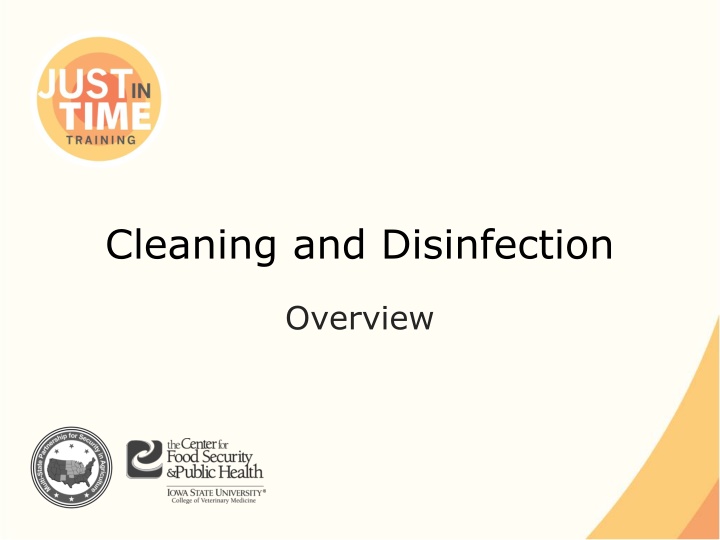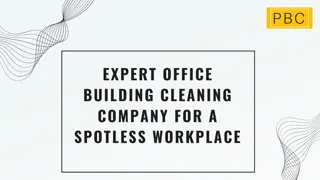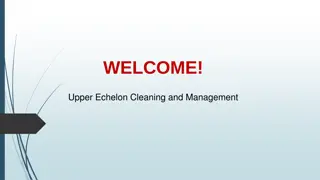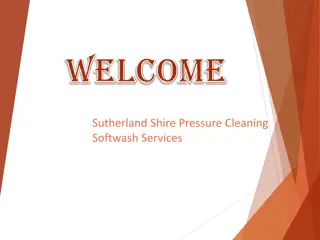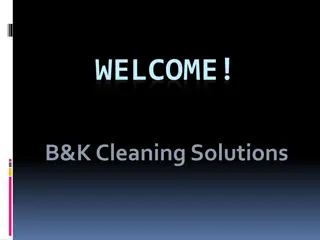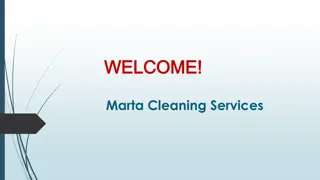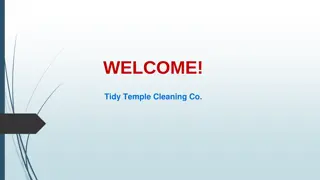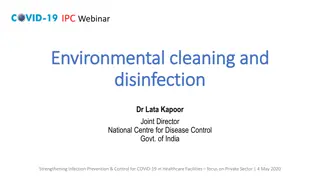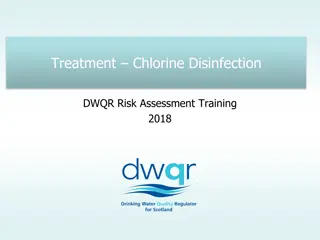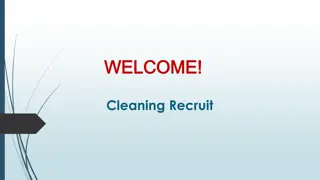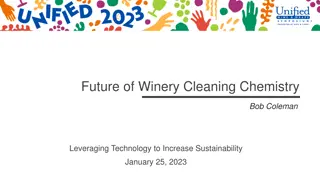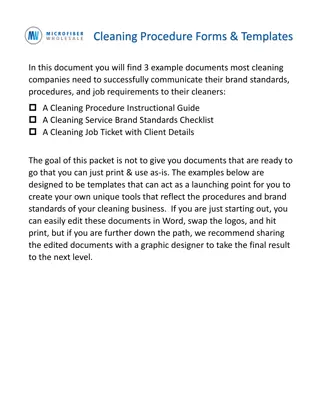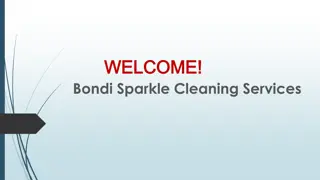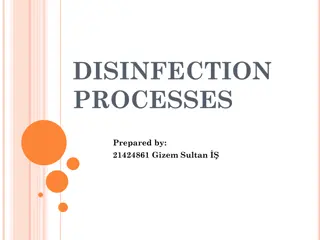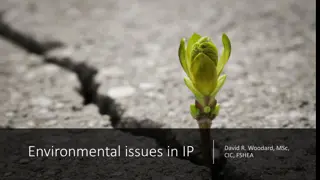Cleaning and Disinfection
This overview covers the importance of cleaning and disinfection in stopping the spread of pathogens, methods such as physical and chemical means, regulations regarding disinfectants, efficacy considerations, basic protocols, and the significance of cleaning before disinfection. It emphasizes the need for proper knowledge, procedures, and safety in cleaning and disinfection practices.
Download Presentation

Please find below an Image/Link to download the presentation.
The content on the website is provided AS IS for your information and personal use only. It may not be sold, licensed, or shared on other websites without obtaining consent from the author.If you encounter any issues during the download, it is possible that the publisher has removed the file from their server.
You are allowed to download the files provided on this website for personal or commercial use, subject to the condition that they are used lawfully. All files are the property of their respective owners.
The content on the website is provided AS IS for your information and personal use only. It may not be sold, licensed, or shared on other websites without obtaining consent from the author.
E N D
Presentation Transcript
Cleaning and Disinfection Overview
Cleaning & Disinfection (C&D) Stop the spread of pathogens Inactivate or destroy microorganisms Vital for animal health emergency situations Premises, equipment, vehicles, personnel Personnel must be knowledgeable C&D methods, procedures, limitations Safety issues Cleaning and Disinfection: Overview Just In Time Training
C&D Methods Reduce, remove, inactivate, destroy Methods vary in level of destruction Physical Heat, UV light Chemical Sanitizers Disinfectants Sterilants Cleaning and Disinfection: Overview Just In Time Training
Disinfectant Regulation Registered and regulated by EPA Federal Insecticide, Fungicide and Rodenticide Act (FIFRA) Antimicrobial pesticides Use in manner inconsistent with label Ineffective application Misuse of product Cleaning and Disinfection: Overview Just In Time Training
Efficacy Considerations Microorganism Considerations Vary in susceptibility Environmental Considerations Organic load Water hardness Temperature Surface type Other chemicals Cleaning and Disinfection: Overview Just In Time Training
Basic C&D Protocol Cleaning Dry Cleaning Washing Rinse and dry Disinfection Application Contact Time Rinse and dry Downtime Cleaning and Disinfection: Overview Just In Time Training
Cleaning Importance Can remove 90% of microorganisms Improves disinfection efficacy Prior to application of disinfectant Three steps Dry clean Wash Rinse and Dry Cleaning and Disinfection: Overview Just In Time Training
Cleaning: Dry Cleaning Removal of gross contamination Organic material Soil, manure, bedding, feed Moisten to control dust Air blowers should not be used Risk of pathogen spread Disposal should minimize spread Burning, burial, composting Cleaning and Disinfection: Overview Just In Time Training
Cleaning: Washing Most overlooked step Detergent Reduces microorganisms Removes oil, grease, exudates Shut off, remove or cover electrical equipment Covered tightly with plastic Electrician may be helpful May need pre-soaked Cleaning and Disinfection: Overview Just In Time Training
Cleaning: Washing High pressure water is very effective Avoid if highly infectious or zoonotic Warm to hot water should be used Scrubbing may be necessary Steam Effective for cracks, crevices, pipework Cleaning and Disinfection: Overview Just In Time Training
Rinse/Dry Rinse with cold water at low pressure Surfaces should be inspected No beading should occur Surfaces should allow to dry completely Overnight if possible Fans can be helpful in drying Do not use with zoonotic pathogens Cleaning and Disinfection: Overview Just In Time Training
Disinfection Application Physical Heat, UV light Chemical Disinfectant Contact time Most important May need reapplication Rinse after contact time Cleaning and Disinfection: Overview Just In Time Training
Downtime Free of any animals or activity Reduces pathogens by drying Time varies based on pathogen Three times expected incubation period Block of area Cleaning and Disinfection: Overview Just In Time Training
Assessment and Planning Identify pathogen Determine areas & items Select proper disinfection method Identify & address hazards & safety issues Determine personnel, equipment & supplies needed Cleaning and Disinfection: Overview Just In Time Training
Site Selection Adjacent to entrance points Two scales Small scale for personnel/small equipment Large scale for vehicles, machinery House C&D components Disinfection station Water supply/waste water containment Cleaning and Disinfection: Overview Just In Time Training
Biosecurity Work Zones Cleaning and Disinfection: Overview Just In Time Training
Disinfectant Preparation Only EPA-registered products Fresh solutions only Old solutions may have reduced efficacy Test kits Determine chemical degradation of active ingredients Cleaning and Disinfection: Overview Just In Time Training
Evaluation Areas properly cleaned/disinfected Personnel aware of/implementing C&D measures Proper disinfectant selected Appropriate concentration Correct contact time achieved C&D Waste Minimize or avoid environmental impact Cleaning and Disinfection: Overview Just In Time Training
Safety Chemical Hazards Skin, eye, respiratory irritation Ingestion (animals) Physical Hazards Slips, trips, falls Heat injury High pressure sprayer Personal Protective Equipment (PPE) Gloves, masks, eyes Cleaning and Disinfection: Overview Just In Time Training
ICS: C&D Group Part of Operations Section of ICS Establish C&D protocols Set up disinfection stations Vehicles Equipment Personnel Cleaning and Disinfection: Overview Just In Time Training
C&D Team C&D Group Supervisor C&D implemented effectively Personnel know proper procedures Identifies team members with required expertise C&D Team Leaders Supervises on site activities C&D Team Members Implement C&D procedures Cleaning and Disinfection: Overview Just In Time Training
Acknowledgments Development of this presentation was by the Center for Food Security and Public Health at Iowa State University through funding from the Multi-State Partnership for Security in Agriculture Authors: Glenda Dvorak, DVM, MPH, DACVPM; Ashley Osborn
